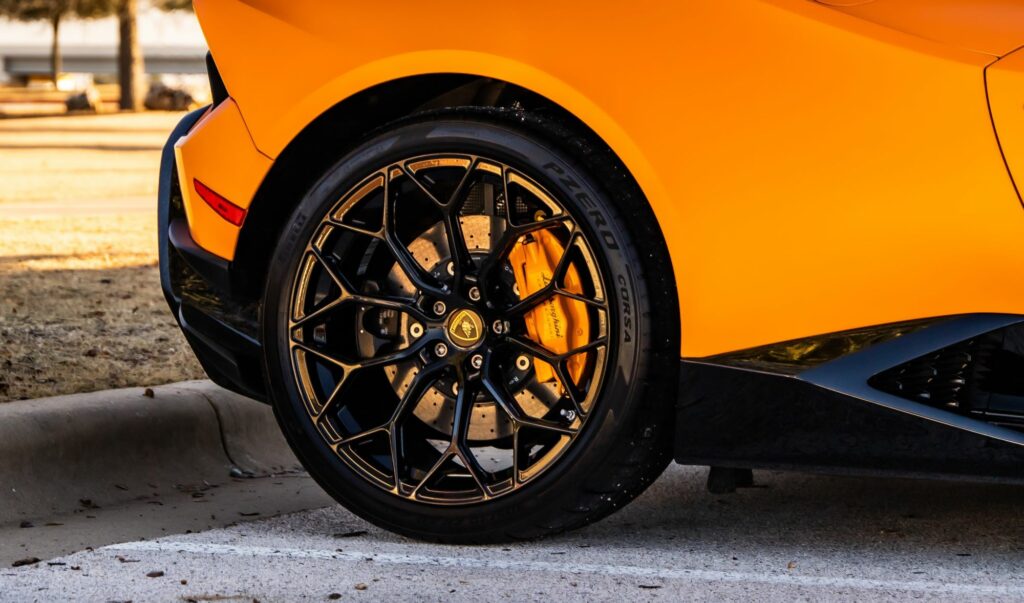Choosing a new car and not sure if you should splash out on those 20″ alloys or not? Or on the lookout for some aftermarket wheels and wondering if 19″ or 20″ wheels will give you what you’re after?
In this article I’ll directly compare these two wheel sizes in terms of:
- Performance and handling
- Comfort
- Aesthetics
- Fuel efficiency
- Noise levels
- Price
Quick Comparison
Larger 20″ wheels feel more sporty and offer sharper handling compared to smaller 19″ wheels. However, 20″ wheels are more expensive, and 19″ wheels result in less road noise, better acceleration, less fuel consumption and a more comfortable ride.
| 19” Alloy Wheels | 20” Alloy Wheels |
| Higher profile tires | Lower profile tires |
| More comfortable | Better handling |
| Less road noise | More road noise |
| Less expensive | More expensive |

Performance and Handling
If you increase the size of your wheel from 19″ to 20″, then it’s highly likely that you’ll also be decreasing the tire aspect ratio (sidewall height) to ensure the wheel still fits into the arch. It’s typically this change from a higher to a lower profile tire which results in the most significant performance and handling changes.
Increasing the alloy size (and hence decreasing the tire sidewall height), will cause the steering to feel sharper and more sporty, by improving cornering and stability. This is a popular reason why some drivers want to go from 19″ to 20″ wheels.
However, bigger alloys are also heavier. As a result, switching from 19″ to 20″ alloys can reduce the acceleration as the car will find it more difficult to get the larger wheels to rotate as quickly.
If you’re just daily driving the car, then you won’t notice a crazy difference between these wheel sizes, however if you’re on the track then it will make a significant difference.
Comfort
When it comes to comfort, 19″ alloys are better than 20″ alloys. This again relates to the tire sidewall height.
Smaller alloys are typically fitted with higher-profile tires (meaning the sidewall height is larger). As a result, there is more cushioning between the driver and the road. Hence, the 19″ wheels will feel smoother and more comfortable, particularly when going over potholes and bumps.
Larger 20″ alloys can feel harsh, particularly if the tires are very low-profile to compensate for the larger rim size.
Make sure you consider the types of roads you’re driving on. If you’re sticking to very good quality roads, then the 20″ alloys shouldn’t cause too much of a problem. But if you’re driving on some dodgy country lanes, you might start to regret the decision of sizing up.

Aesthetics
One of the main reasons why a lot of car owners want to step up from 19″ to 20″ wheels, is for aesthetics. In general, bigger alloys (and hence, lower profile tires) look better. It’s one of the reasons why car manufacturers put larger alloys on their more expensive trim-levels, as it sucks more people into upgrading.
However, it’s important to note that 20″ wheels are huge, and for a lot of cars they can just look too big. It’s all personal preference, but when the wheel is so big that the tire ends up looking like an elastic band around it just to get it to fit in the arch, I just don’t think it looks that great.
I’d highly recommend checking out the Fitment Industries Gallery to see what you like the look of before ordering anything. You can select your make and model of car and then the wheel and tire size to see photos of other cars with those specs. That way you can easily figure out if 20″ is too big, or just right.

Fuel Efficiency
Switching between 19″ and 20″ wheels is unlikely to cause a significant change in fuel economy, however the larger wheels will be slightly less fuel efficient. This is because they are heavier which means more fuel will be needed to more the car the same distance at the same speed.
However, the difference is minimal and this is one of the lesser factors to consider. If you’re worried about it though, make sure you pay attention to the tire’s efficiency rating as it varies between make and model. For example, you could easily find an R19 tire with a lower efficiency rating compared to a R20 tire, which will offset the size difference.
Noise Levels
Another lesser important factor to consider is the noise level. Again, like with the fuel efficiency, the difference is pretty minimal and I personally wouldn’t place too much importance on it. The tire make and model will also affect the noise level, as well as the size so there are plenty of other variables in play here.
With that said, the 20″ wheels will create more road noise compared to the 19″ wheels, if you opt for lower-profile tires to get the same overall wheel size. Chunkier tires put more space between the road and the people inside the car which tends to quieten the road noise.
Price
Larger alloys are more expensive compared to smaller alloys, in the vast majority of cases. Check out this table comparing the price of the 19″ and 20″ versions of the same wheel to demonstrate.
| Wheels | 19” Price | 20” Price | % Increase |
| Konig Ampliform | $1425 | $1680 | 18% |
| Vossen HF5 | $2400 | $2800 | 17% |
| BBS CIR | $3100 | $3520 | 14% |
| Rotiform TUF | $3250 | $3600 | 11% |
You should also check out the difference in the tire price, as this is also highly significant. Again, in almost all cases, R20 tires are more expensive. I say in “almost all cases” because it will also depend on the wheel width and aspect ratio, as having a more unique wheel size will result in a higher price compared to a more popular size.
Want to learn more about the pros and cons of small and large wheels? Check out my complete guide to why wheel size matters to learn more.
Alloy and Tire Size Compatibility
Changing the size of your wheels from 19″ to 20″ (or vice-versa) will also have an impact on the tire size you need to run. Most people try and keep the overall wheel size as close as possible to the original wheel so it fits into the arch comfortably, and so that the speedometer doesn’t need recalibrating.
If you increase your overall wheel size then your car’s speedometer will say the vehicle is travelling slower than it actually is. Hence, keeping the overall wheel size similar is important.
If you go from a 19″ to a 20″ alloy, then the sidewall height of the tire will need to decrease to keep the overall wheel the same size.

The sidewall height is determined by the tire’s aspect ratio measurement.
Tire sizes are denoted by three measurements:
- Width: this refers to how wide the tread is in millimetres.
- Aspect ratio: this is a percentage of the width.
- Alloy size: this is measured in inches.
Check out this example below.

This tyre is 195 mm wide, has an aspect ratio of 50% and is designed for a 16″ alloy wheel. In this case, the tire side wall will be 97.5 mm (50% of 195 mm).
It’s important to note that you can’t read the aspect ratio in isolation. You must always also consider the tire width as well.
Consider these two tire sizes:
- 195/50 R16
- 205/50 R16
The 195/50 R16 tire has a sidewall height of 97.5 mm (50% of 195 mm). The 205/50 R16 tire has a sidewall height of 102.5 mm (50% of 205 mm). Hence, it’s important to always calculate the sidewall height when comparing tire sizes, as the difference can be quite significant when the tire width varies between them.
Changing Wheel Sizes
The reason that I’m explaining all this is because it’s actually the change in the tires aspect ratio (profile height) when going from a 18″ to 19″ alloy which makes a difference, as well as the alloy size itself. When changing alloy size, you also will need new tires as these will be a different size.
Example #1
Let’s take a Jaguar F-Pace (2021) as an example which comes with the following standard wheel and tire sizes:
- 19″ wheels and 255/55 R19 tires
- 20″ wheels and 255/50 R20 tires
| Measurement | 255/55 R19 | 255/50 R20 |
| Rim Size | 19” | 20” |
| Tire Width | 255 mm | 255 mm |
| Tire Aspect Ratio | 55% | 50% |
| Actual Sidewall Height | 140 mm | 128 mm |
| Overall wheel diameter | 763 mm | 763 mm |
As you can see from the table, these tires have the exact same with (255 mm), hence the only measurements that are varying are the rim size and aspect ratio.
To compensate for the larger rims, the aspect ratio of must decrease to ensure the wheel is the same overall diameter. A decrease of 5% of the aspect ratio and increase of 1″ of the rim size, causes both of these wheels to measure the same overall diameter.
Example #2
Let’s take an Audi RS5 (2022) as another more complicated example which comes with the following 19″ and 20″ wheel and tire size options:
- 19″ wheels and 265/35 R19 tires
- 20″ wheels and 275/30 R20 tires
Since all three measurements (width, aspect ratio and rim size) vary here, the results are more complicated.
| Measurement | 265/35 R19 | 275/30 R20 |
| Rim Size | 19” | 20” |
| Tire Width | 265 mm | 275 mm |
| Tire Aspect Ratio | 35% | 30% |
| Actual Sidewall Height | 92.75 mm | 82.5 mm |
| Overall wheel diameter | 668 mm | 673 mm |
When comparing these two wheel and tire sizes, you’ll notice that despite all three measurements varying, the overall wheel diameter is very similar and hence, the speedometers read almost the exact same. Hence, the wheel size change doesn’t cause a problem.

